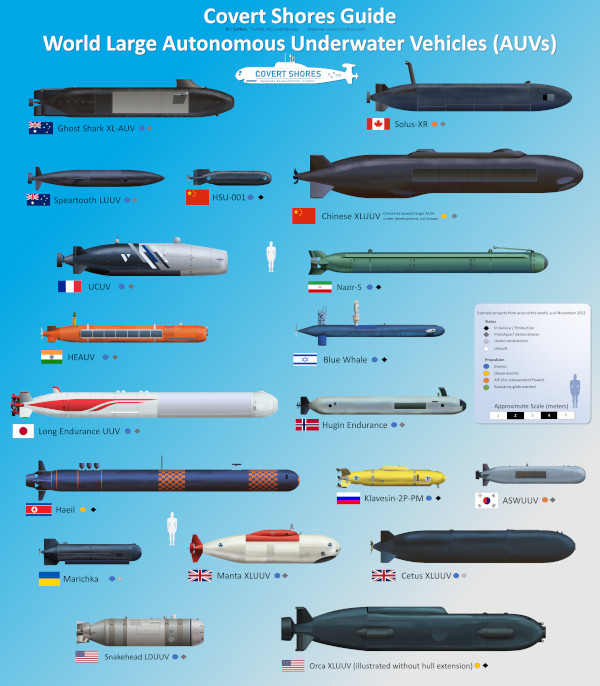World Guide To Large Underwater Drones














 The world of underwater drones (AUVs - autonomous underwater vehicles) is changing rapidly. Within the past 2-3 years more and more navies are seriously developing extra-large vehicles (XLUUVs). A lot has changed since I first did a Large Underwater Vehicles graphic (see 2019 poster and December 2022 poster). This is a guide to the most relevant naval types around the world today.
The world of underwater drones (AUVs - autonomous underwater vehicles) is changing rapidly. Within the past 2-3 years more and more navies are seriously developing extra-large vehicles (XLUUVs). A lot has changed since I first did a Large Underwater Vehicles graphic (see 2019 poster and December 2022 poster). This is a guide to the most relevant naval types around the world today.
World projects in alphabetic order, by Country:
Ghost Shark XL-AUV, Australia
 Ghost Shark XLAUV (Extra-Large Autonomous Underwater Vehicle) is being jointly developed by Anduril Australia and the Australian Government as part of the Advanced Strategic Capabilities Accelerator (ASCA). An order for three prototypes was announced in May 2022 and the first vessel was launched in April 2024.
Ghost Shark XLAUV (Extra-Large Autonomous Underwater Vehicle) is being jointly developed by Anduril Australia and the Australian Government as part of the Advanced Strategic Capabilities Accelerator (ASCA). An order for three prototypes was announced in May 2022 and the first vessel was launched in April 2024.
The design has a square cross-section. This, maximizes internal volume while keeping the outer dimensions within the bounds of a standard shipping container. Production likely involves significant elements of 3D printing, a technique Anduril has used on the earlier Dive-LD vehicle.
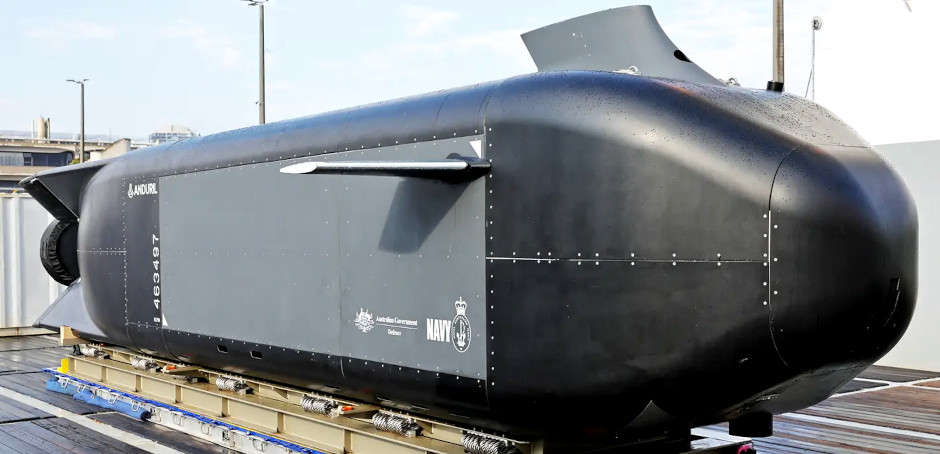
Speartooth LUUV, Australia
 C2 Robotics' Speartooth Large Uncrewed Underwater Vessel (LUUV) is intended for long range, long duration missions. It is designed as a relatively low-cost, easy to manufacturer platform. Capabilities are modular, and it is rapidly reconfigurable to meet new mission needs.
C2 Robotics' Speartooth Large Uncrewed Underwater Vessel (LUUV) is intended for long range, long duration missions. It is designed as a relatively low-cost, easy to manufacturer platform. Capabilities are modular, and it is rapidly reconfigurable to meet new mission needs.
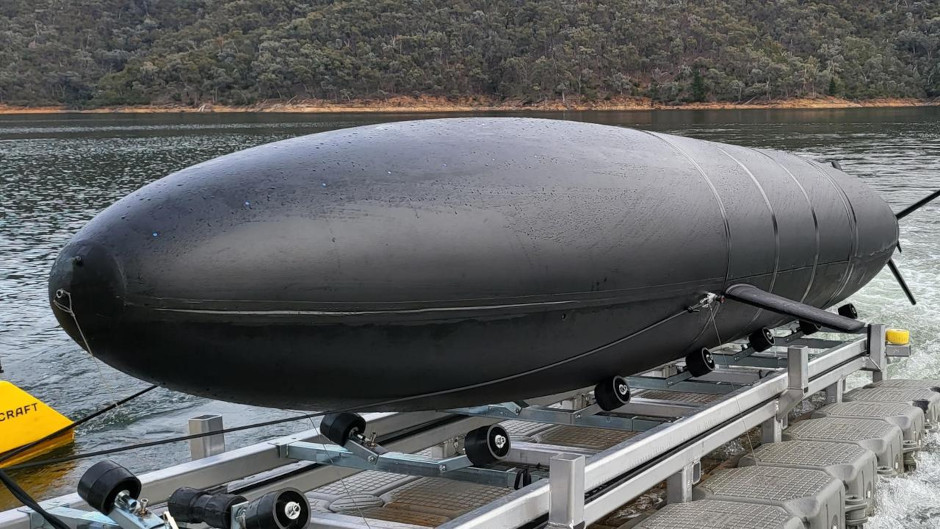
Solus-XR, Canada
 Solus-XR is a fuel cell powered extra-large uncrewed underwater vehicle (XLUUV) platform. It is designed for port to port, lightly supervised missions over long ranges. It's air-independent power (AIP) allows extended range missions of up to 2,700 nautical miles (5,000 km) and an endurance of 45 days. It can carry payloads in two large removable payload modules. These can include thin line towed array sonar (TAS), various weapons, smaller AUVS, a seafloor suction anchor. The payload sections can also be fitted with additional lithium-based batteries to increase sprint endurance.
Solus-XR is a fuel cell powered extra-large uncrewed underwater vehicle (XLUUV) platform. It is designed for port to port, lightly supervised missions over long ranges. It's air-independent power (AIP) allows extended range missions of up to 2,700 nautical miles (5,000 km) and an endurance of 45 days. It can carry payloads in two large removable payload modules. These can include thin line towed array sonar (TAS), various weapons, smaller AUVS, a seafloor suction anchor. The payload sections can also be fitted with additional lithium-based batteries to increase sprint endurance.
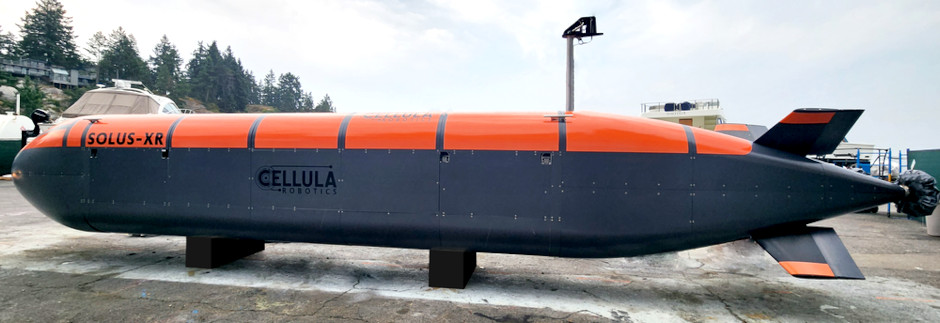
Solus-XR Specifications
Length: 12 m
Cross-section: 1.7 x 1.7 m
Displacement: 10 tonnes
Range: 2,700 nautical miles (5,000 km) over 45 days
Sprint Speed: 8 kts
HSU-001, China
 China unveiled the HSU-001 at the 70th anniversary of the People’s Republic of China (PRC) in Beijing in October 2019. The design appears to be intended primarily for Intelligence, Surveillance and Reconnaissance (ISR). It features twin screw-back propellers suggesting that it is optimized for slow speed cruising. It has both vertical and horizontal thrusters both fore and aft. The spikes on the top of the hull are for launch and recovery, suggesting that it is deployed from surface vessels. There appear to be external stores mounting points (‘hard points’) either side of the hull.
China unveiled the HSU-001 at the 70th anniversary of the People’s Republic of China (PRC) in Beijing in October 2019. The design appears to be intended primarily for Intelligence, Surveillance and Reconnaissance (ISR). It features twin screw-back propellers suggesting that it is optimized for slow speed cruising. It has both vertical and horizontal thrusters both fore and aft. The spikes on the top of the hull are for launch and recovery, suggesting that it is deployed from surface vessels. There appear to be external stores mounting points (‘hard points’) either side of the hull.
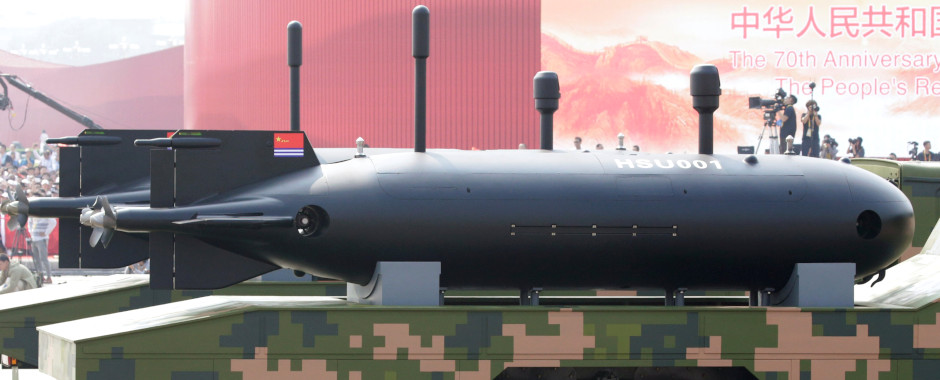
Various XLUUVs, China
 China has at least five extra-large UUV designs which are known through open source intelligence (OSINT), but have not been publicly revealed. Three of these are the same size or larger than the U.S. Navy's Orca XLUUV. Their names, manufacturers and roles are unclear, as is which ones will enter service with the Chinese Navy (PLAN). The below graphic, used by shipbuilder CSSC at a defense show in 2023, is likely indicative of at least one model. Note the apparent torpedo tubes in the bow.
China has at least five extra-large UUV designs which are known through open source intelligence (OSINT), but have not been publicly revealed. Three of these are the same size or larger than the U.S. Navy's Orca XLUUV. Their names, manufacturers and roles are unclear, as is which ones will enter service with the Chinese Navy (PLAN). The below graphic, used by shipbuilder CSSC at a defense show in 2023, is likely indicative of at least one model. Note the apparent torpedo tubes in the bow.
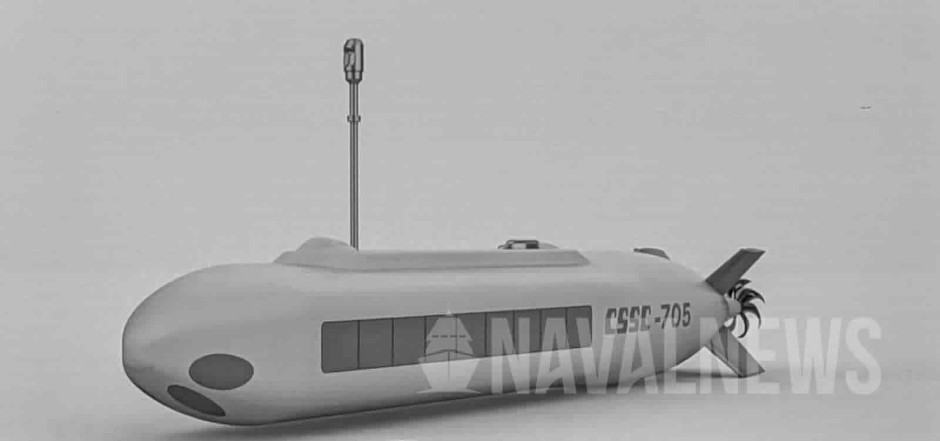
Image via Naval News
UCUV, France
 Naval Group's Unmanned Combat Underwater Vehicle (UCUV) started as a company project with the first vehicle, the 'Oceanic Underwater Drone Demonstrator', being publicly revealed in October 2021. In December 2023 the French government ordered a prototype demonstrator, formalizing the program.
Naval Group's Unmanned Combat Underwater Vehicle (UCUV) started as a company project with the first vehicle, the 'Oceanic Underwater Drone Demonstrator', being publicly revealed in October 2021. In December 2023 the French government ordered a prototype demonstrator, formalizing the program.
The original demonstrator was damaged by a fire on an nearby yacht during trials. An improved vessel was subsequently relaunched. The design features a sophisticated hydrodynamic hull form with, unusually, large flank array sonar and an integral payload bay in the belly. The vehicle is around 10 meters long but there are plans to increase its size to around 20 meters in length if required.
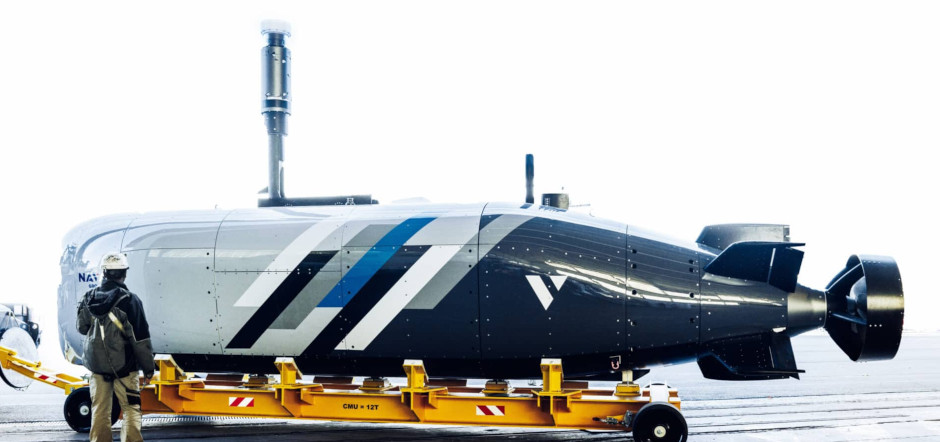
HEAUV, India
 The High Endurance Autonomous Underwater Vehicle (HEAUV) is under development by India's Defence Research & Development Organisation (DRDO). Development is being carried out at the Cochin Shipyard, International Ship Repair Facility (ISRF) in Kochi. The design is a simple torpedo-like form with X-form rudders and large sonar arrays.
The High Endurance Autonomous Underwater Vehicle (HEAUV) is under development by India's Defence Research & Development Organisation (DRDO). Development is being carried out at the Cochin Shipyard, International Ship Repair Facility (ISRF) in Kochi. The design is a simple torpedo-like form with X-form rudders and large sonar arrays.
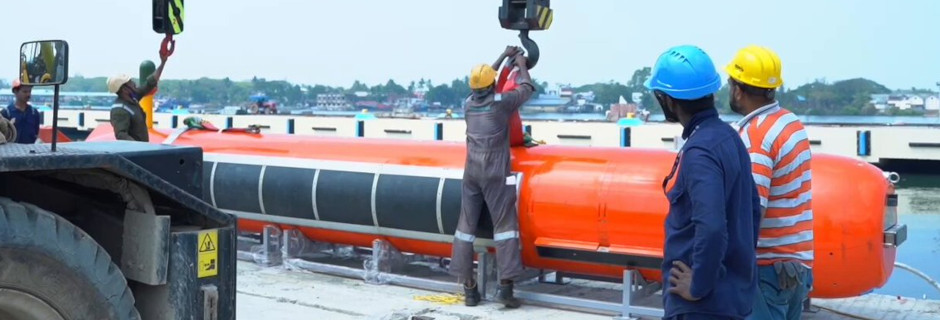
Nazir-5, Iran
 The Nazir-5 is a torpedo-like battery powered vehicle. A factor in its large size is likely to be the use of traditional lead-acid batteries. Despite that, it has a reported range of at least 500 km. Its role and capabilities are unclear but it is a distinct possibility that it can be weaponized as a one-way-attack underwater drone.
The Nazir-5 is a torpedo-like battery powered vehicle. A factor in its large size is likely to be the use of traditional lead-acid batteries. Despite that, it has a reported range of at least 500 km. Its role and capabilities are unclear but it is a distinct possibility that it can be weaponized as a one-way-attack underwater drone.

Blue Whale, Israel
 The ELI-3325 'Blue Whale' UUV has been developed by IAI. It is designed for intelligence gathering (ISR), anti-submarine warfare (ASW), mine countermeasures (MCM). A major feature is the electro-optical / sensor mast. This allows it to detect and track targets, both above and below surface, and perform onboard sensor data processing. It can transmit intelligence back using a dedicated broadband-secured satellite channel.
The ELI-3325 'Blue Whale' UUV has been developed by IAI. It is designed for intelligence gathering (ISR), anti-submarine warfare (ASW), mine countermeasures (MCM). A major feature is the electro-optical / sensor mast. This allows it to detect and track targets, both above and below surface, and perform onboard sensor data processing. It can transmit intelligence back using a dedicated broadband-secured satellite channel.
The project was previously known as the Caesaron, and the vehicle itself bears an unmistakable resemblance to the Canadian ISE Explorer family of UUVs.
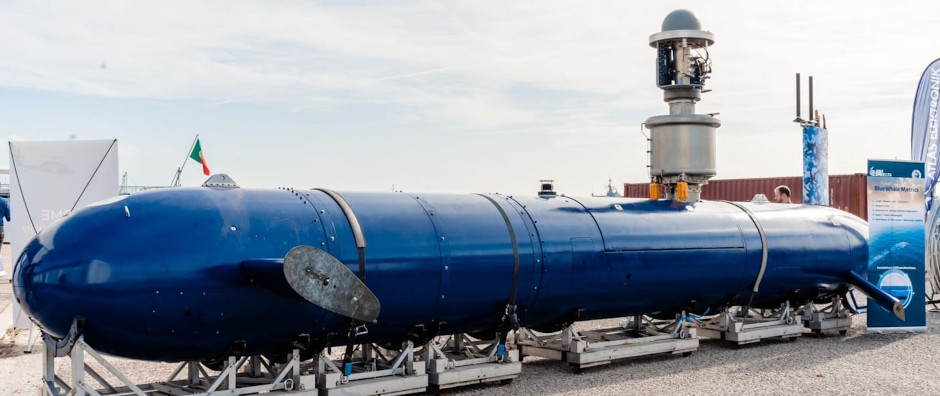
Long Endurance UUV, Japan
 Japan's ATLA (Acquisition, Technology & Logistics Agency) is developing the Long Endurance UUV (uncrewed underwater vehicle). The prototype has been in the water since 2023. The baseline configuration is 10 meters long by 1.8 meters diameter. This can be extended to 15.6 meters with the addition of a payload module.
Japan's ATLA (Acquisition, Technology & Logistics Agency) is developing the Long Endurance UUV (uncrewed underwater vehicle). The prototype has been in the water since 2023. The baseline configuration is 10 meters long by 1.8 meters diameter. This can be extended to 15.6 meters with the addition of a payload module.
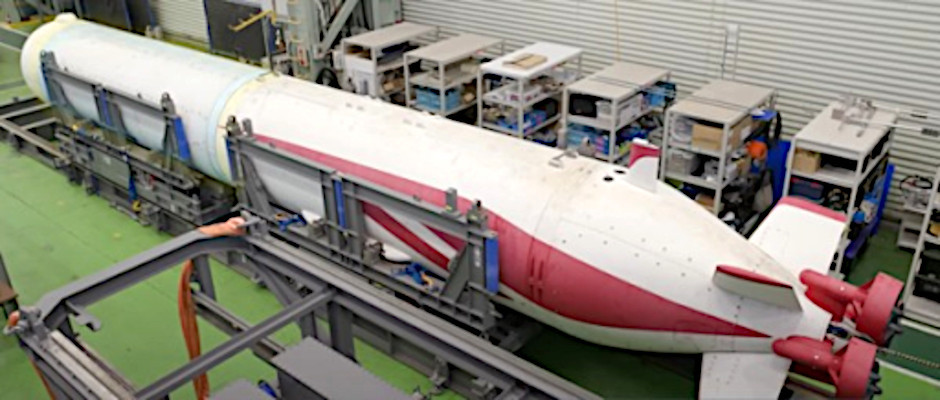
Haeil, North Korea
 A very large drone displayed in a military parade in July 2023, this is likely an enlarged and more capable cousin of the Haeil-2 revealed in April 2023. The vehicle is torpedo-like and is reportedly armed, intended to strike fixed targets. It appears to have a row of snorkel intakes in the aft section. This suggests carbon fuel propulsion (e.g. Diesel) which would match with the claimed range of 1,000km. If correct, the vessel would have to travel awash, thus reducing its stealth.
A very large drone displayed in a military parade in July 2023, this is likely an enlarged and more capable cousin of the Haeil-2 revealed in April 2023. The vehicle is torpedo-like and is reportedly armed, intended to strike fixed targets. It appears to have a row of snorkel intakes in the aft section. This suggests carbon fuel propulsion (e.g. Diesel) which would match with the claimed range of 1,000km. If correct, the vessel would have to travel awash, thus reducing its stealth.
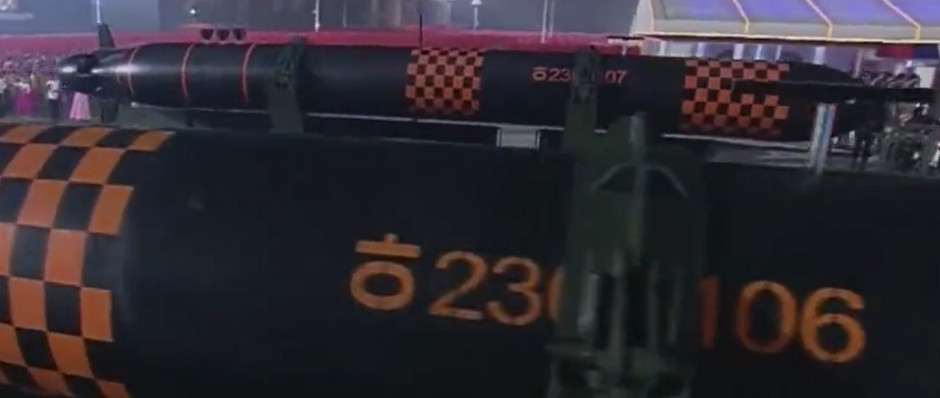
The weapon is remarkably similar to Russia's Poseidon (KANYON). That Intercontinental Nuclear-Powered Nuclear-Armed Autonomous Torpedo is one of Russia's super weapons. This new drone-torpedo is likely intended to be North Korea's close equivalent, at least in propaganda terms.
Haeil Specifications (provisional)
Length: 16 meters
Diameter: 1.5-1.6 meters
Warhead: Conventional or nuclear
Propulsion: Diesel-electric (to be confirmed)
Range: 1,000km (540 nautical miles) < reported in April 2023
Speed: 4.6 knots < reported in April 2023for Haeil, likely much faster at terminal phase
Depth: 80-100 meters < reported in April 2023
Hugin Endurance, Norway
 The Hugin Endurance is the largest member of the Hugin family of drones from Norwegian manufacturer Kongsberg. It has a range of 2200 km / 1200 nm and endurance of 15 days.
The Hugin Endurance is the largest member of the Hugin family of drones from Norwegian manufacturer Kongsberg. It has a range of 2200 km / 1200 nm and endurance of 15 days.
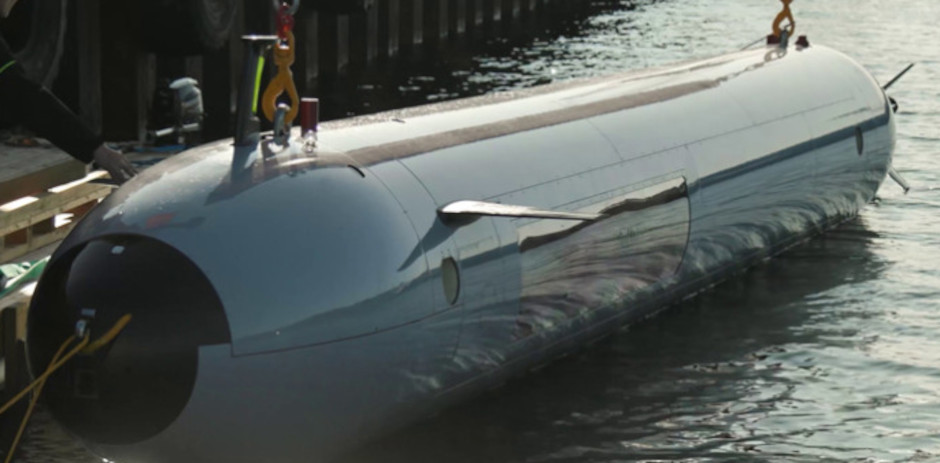
Klavesin-2P-PM, Russia
 The Klavesin-2P-PM (Клавесин-2Р-ПМ) is a member of the Harpsichord ('Klavesin') family of mid-sized UUVs. It can be carried by surface vessels and has become a standard feature of Russian Navy nuclear submarines. It provides them with an improved Intelligence Surveillance and Reconnaissance (ISR) capability.
The Klavesin-2P-PM (Клавесин-2Р-ПМ) is a member of the Harpsichord ('Klavesin') family of mid-sized UUVs. It can be carried by surface vessels and has become a standard feature of Russian Navy nuclear submarines. It provides them with an improved Intelligence Surveillance and Reconnaissance (ISR) capability.
Rubin has also developed the Vityaz-D design for deep diving missions up to 6,000 meters.
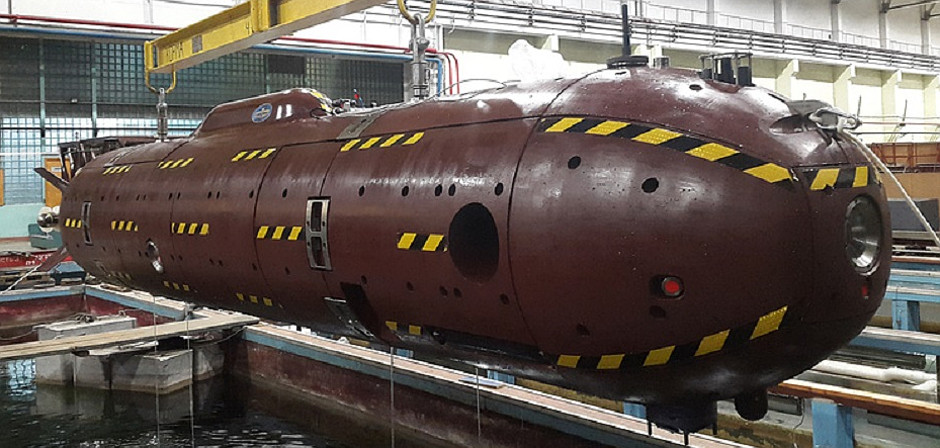
ASWUUV, South Korea
 The ASWUUV (anti-submarine uncrewed underwater vehicle) is a mid-sized vehicle developed by Hanwha Systems. Based on reported specifications, it has a high cruising speed and extremely long endurance. The prototype has been in testing since 2022. South Korean shipbuilders have a number of larger UUV projects in the works.
The ASWUUV (anti-submarine uncrewed underwater vehicle) is a mid-sized vehicle developed by Hanwha Systems. Based on reported specifications, it has a high cruising speed and extremely long endurance. The prototype has been in testing since 2022. South Korean shipbuilders have a number of larger UUV projects in the works.

ASWUUV Specifications
Length: 6.5 m
Weight: 9 tonnes
Cruising speed: 10 kt
Operating depth: 300 m
Submerged endurance: 430 days
Marichka, Ukraine
 The Marichka (МАРІЧКА) is a large autonomous underwater vehicle (AUV) developed by AMMO Ukraine. Among the many large AUV projects around the world, it is possibly the first born directly from wartime needs. The project is separate to the Toloka family of AUVs which are also being developed in Ukraine. The batteries and explosives are carried in the main sealed steel pressure hull.
The Marichka (МАРІЧКА) is a large autonomous underwater vehicle (AUV) developed by AMMO Ukraine. Among the many large AUV projects around the world, it is possibly the first born directly from wartime needs. The project is separate to the Toloka family of AUVs which are also being developed in Ukraine. The batteries and explosives are carried in the main sealed steel pressure hull.
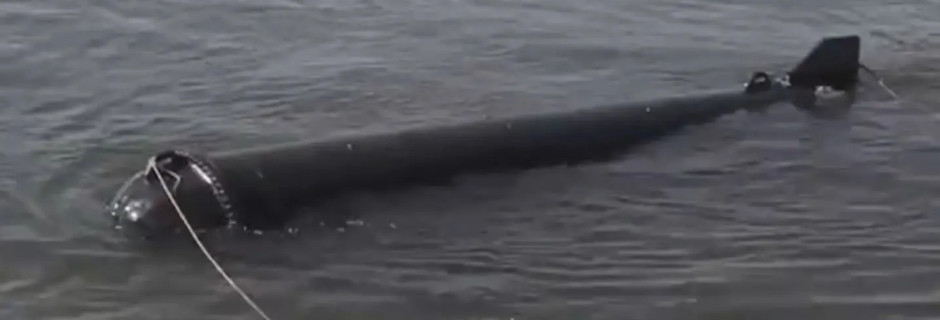
According to the manufacturer the system is intended for anti-ship, anti-bridge, intelligence gathering and transport. Range is reportedly 1,000km. Unit cost is stated as 16 million UAH, equivalent to 433k USD.
Manta, United Kingdom
 As a first step the Royal Navy recently announced the contract for the Manta XLUUV (Extra-large Uncrewed Underwater Vehicle). British based MSubs, who have built a number of small crewed submersibles, won the deal with a proposal to convert the existing S201 crewed submersible.
As a first step the Royal Navy recently announced the contract for the Manta XLUUV (Extra-large Uncrewed Underwater Vehicle). British based MSubs, who have built a number of small crewed submersibles, won the deal with a proposal to convert the existing S201 crewed submersible.
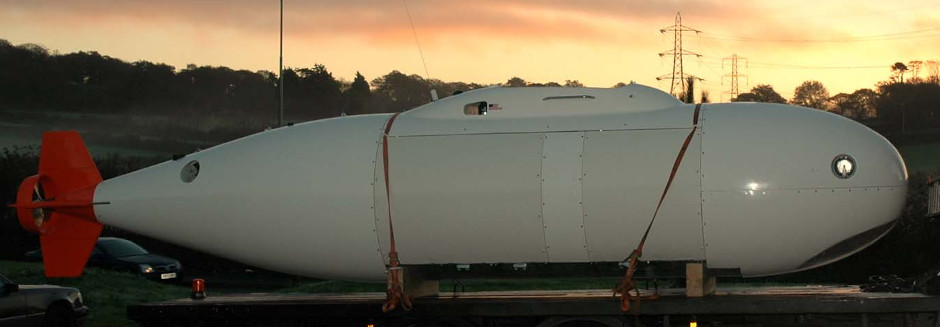
XLUUV/Manta/S201 Specifications
Length: 9 m (30 ft)
Beam: 2 m (6.5 ft)
Weight: 9 tonnes
Operating depth: 305 m (1148 ft)
Submerged Duration: 48 hrs
Submerged Speed: 12 kt
CETUS, United Kingdom
 Following the Manta XLUUV project the Royal Navy has ordered production of the same company's CETUS design. The vehicle will have a large payload space for smaller AUVs, ROVs or, possibly, weapons. In common with some other leading designs designs it appears sized to fit within a standard shipping container, greatly increasing its transportability.
Following the Manta XLUUV project the Royal Navy has ordered production of the same company's CETUS design. The vehicle will have a large payload space for smaller AUVs, ROVs or, possibly, weapons. In common with some other leading designs designs it appears sized to fit within a standard shipping container, greatly increasing its transportability.
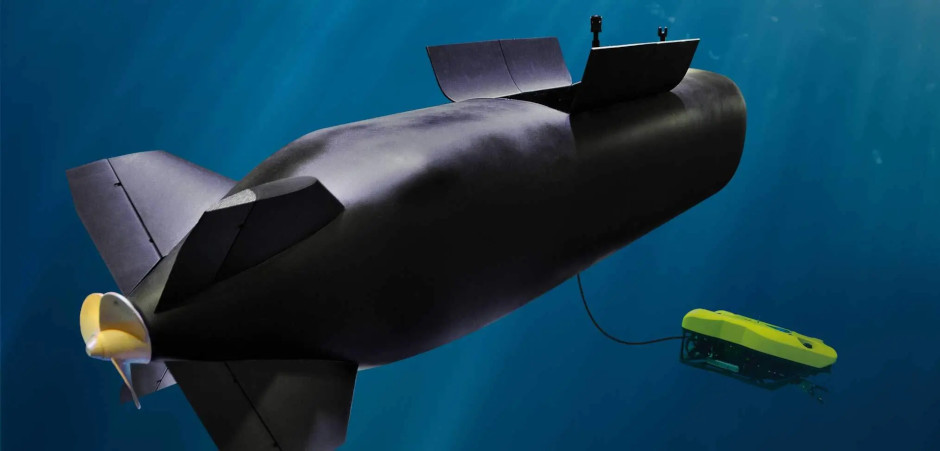
Snakehead LDUUV, United States
 The Snakehead LDUUV (large displacement underwater vehicle) is expected to enter service with the U.S. Navy. There was a period when it appeared to have been cancelled, but was reaffirmed in March 2024. Approximately the same size as a SEAL delivery vehicle (SDV), it can be carried by submarines equipped with a dry deck shelter (DDS).
The Snakehead LDUUV (large displacement underwater vehicle) is expected to enter service with the U.S. Navy. There was a period when it appeared to have been cancelled, but was reaffirmed in March 2024. Approximately the same size as a SEAL delivery vehicle (SDV), it can be carried by submarines equipped with a dry deck shelter (DDS).
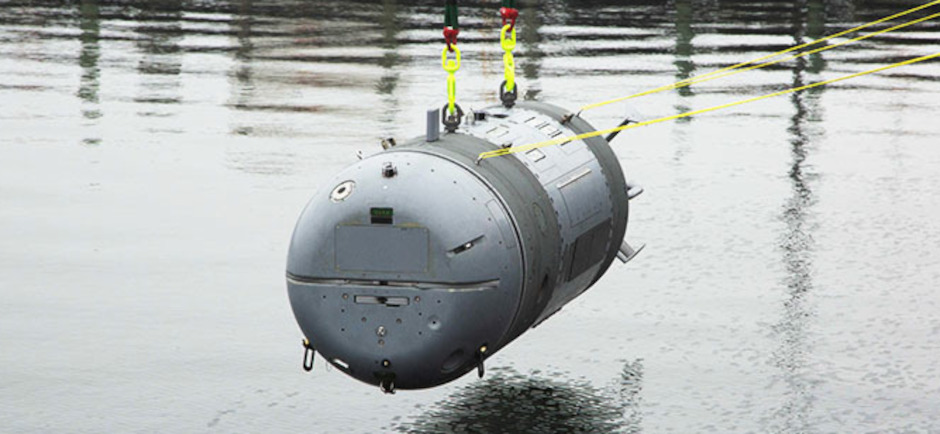
Orca XLUUV, United States
 One of the first, and largest, XLUUV designs, the Boeing Orca will keep the U.S. Navy at the forefront of naval technology. In order to increase endurance it uses a diesel-electric propulsion system., providing it with a range of over 6,000 nautical miles.
One of the first, and largest, XLUUV designs, the Boeing Orca will keep the U.S. Navy at the forefront of naval technology. In order to increase endurance it uses a diesel-electric propulsion system., providing it with a range of over 6,000 nautical miles.

Indicative Specifications (based on Boeing Echo Voyager base)
Length: 15.5 m normal, 25.9 meters with payload insert
Beam: 2.6 m
Height: 2.6 m
Weight in Air: 50 tons (45,360 kg)
Depth: 3,000 m
Speed: 8.0 kt maximum, 2.5-3 kt cruising
Range between recharges: ~150 nautical miles at nominal speed
Related articles (Full index of popular Covert Shores articles)





 World survey of Underwater Attack Drones (OWA-AUVs)
World survey of Underwater Attack Drones (OWA-AUVs)

 Ukraine's Maritime Drones (USVs)
Ukraine's Maritime Drones (USVs)

 Ukraine's long-ranged attack drones (OWA-UAVs)
Ukraine's long-ranged attack drones (OWA-UAVs)













 World guide to Heavyweight Torpedoes
World guide to Heavyweight Torpedoes


